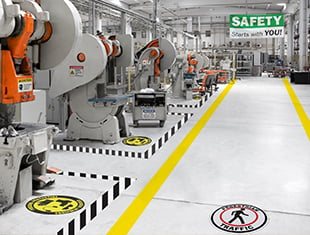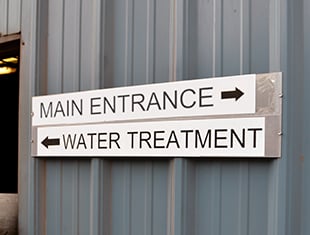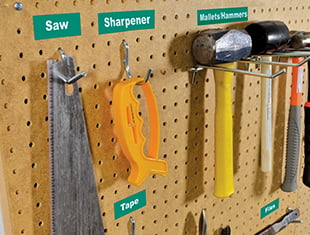Implementing 5S In Your Workplace
Webinar | Implementing 5S
Implementing 5S In Your Workplace
Improve workplace efficiency through organization, cleanliness, and visual communication with the 5S System. Led by Compliance Specialist Brian McFadden, the 30-minute webinar illustrates the basics and origins of 5S, breaks down each of the five steps, and explains how get started with 5S in your own facility.
 30 MINS
30 MINS Presented By

Brian McFadden
Technical Writer
Compliance Specialist
Related Resources
Transcript
Webinar Preview
Contents of the Implementing 5S In Your Workplace Webinar:
- The basics and origins of 5S
- How the 5S System can help your facility
- The philosophies and processes behind each of the five S's
- The benefits and costs of 5S
- And how all the components of 5S tie together
Excerpt from the Implementing 5S In Your Workplace Webinar transcript:
What is 5S?
At its most basic, the 5S concept is designed to improve workplace efficiency through facility-wide organization, cleanliness, and visual communication -reducing costs and boosting productivity.
The 5Ss were developed in Japan, and stand for the Japanese words Seiri [s -D ] (tidiness), Seiton [S -to'] (orderliness), Seiso [S -so] (cleanliness), Seiketsu [S -k -TS ] (standardization), and Shitsuke [SH -ts'k ] (discipline) . Each sequential step contributes to the broader goals of organizing a workspace efficiently and sustaining a culture of cleanliness.
The English translations of these words have been chosen to preserve the 5Ss, as a memory aid. They are usually presented as:
. Sort, which identifies the tools and supplies that are important in a work area, and removes the equipment and material that isn't needed.
. Set, which organizes everything that's left in a work area to help workers find what they need, when they need it.
. Shine, which includes regular cleaning, inspection, and maintenance, making it simpler to spot potential problems.
. Standardize, which documents the improvements that have been made so they can be maintained in the future, and shared with other parts of the facility.
. Sustain, which seeks to maintain what's been accomplished through regular evaluation, open communication, and ongoing training - and through repeating the 5S cycle, as needed.
We'll explore each of these in further detail later in the webinar.
Where Did 5S Originate?
The seeds for 5S were first planted as far back as the Industrial Revolution. In response to the rapidly-changing workplace, factory owners and manufacturers sought to maximize efficiency and increase productivity, core principles at the heart of the 5S system.
But the modern form of 5S took shape in Japan during post-World War II reconstruction. In the wake of the war, the Toyota Motor Company developed numerous lean manufacturing tools as part of its Toyota Production System, including Kaizen, Kanban, and Total Productive Maintenance. According to Toyota, the new system was dedicated to "the complete elimination of all waste." This refers to both waste materials and unhelpful work practices.
5S rose to prominence as part of the Toyota Production System, and has become one of its best-known methods for improving efficiency. 5S gained traction, in part, because it's easy to implement, but it also interconnects well with other lean manufacturing tools. The system provides a roadmap for the continuous improvement at the heart of Kaizen, for instance, and 5S shares an emphasis on visual order with Kanban.
American managers were taking note by the mid-1980s, and began applying similar methods to reduce costs in the United States. In the decades since then, 5S has become a foundation of effective, clean, organized workplaces around the world.
What does 5S look like in practice?
5S isn't limited to manufacturing. The concept has been used in various industries around the world to streamline operations, improve efficiency, and ensure safety. For example:
. A Michigan automotive company applied lean principles to their engineering processes in order to eliminate wasted work, define common communication protocols, and adopt a shared technology platform
. A recent study concluded that instrument use could be reduced by 70% during certain surgical procedures with 5S
. A truck trailer manufacturer used 5S to dramatically reduce workplace accidents and related sick leave
How Can 5S Help Your Facility?
5S looks different in every facility, depending on the needs, processes, and culture of any given workforce. But, no matter how it's done, the 5S methodology offers numerous benefits:
. 5S can improve profitability by saving labor hours, money, and other resources that might otherwise be wasted trying to find tools or supplies.
. It creates a more efficient workforce by standardizing work procedures. This allows employees to focus solely on important tasks.
. The system increases productivity by reducing the overall time needed to clean and prepare for a task.
. It can mean a safer workplace. Employees are safer in an organized facility that minimizes risks, reduces hazards, and promotes cleanliness.
What are the 5S's?
Individually, each step of 5S promotes an efficient, clean, organized workplace. Taken together, however, they can have enormous effects on a company's culture and bottom line. We'll explore each "S," one by one, in further detail.
Sort
The first step in 5S is to sort. This part of the process is about ensuring a workspace has exactly what it needs. "Sort" through everything in each work area. Keep only what is essential to completing that station's work, and move unnecessary tools and supplies to a common storage area. Items that aren't used at all can often be discarded or recycled.
Sorting involves four steps:
. Classifying Equipment and Tools
. Determining Ownership
. Red Tagging Unnecessary Items
. and Recycling and Reassigning Tools
We'll cover those steps in greater detail.
Classifying
The first step in Sorting is to identify the tools, equipment, materials, and supplies in each work area. Everything in a workstation should be grouped into one of three categories: "Always Needed," "Often Needed," and "Other." Anything that is always or often needed in a work area should stay in that work area; you'll organize them into place in a later step. All of the "Other" materials should be removed; dealing with them is the next part of the Sort process.
Ownership
Often, items in one workstation's "Other" category are actually needed somewhere else. The second phase of Sorting is to figure out who owns the items, whether that might be individual employees, departments, or process lines. In some cases, ownership is shared among several groups; usually, this means the item really belongs in a central storage location, like a tool cage.
Once ownership is determined, the owners can decide what to do with the item. In some cases, the ownership of an item may not be readily apparent, or no owner will have a current need for the item. Those situations bring us to the third step in 5S sorting: Red tagging.
Red Tagging
If an item's owner can't be determined, or if the owner doesn't actually need it, the item should be "red tagged." This involves hanging a highly-visible red tag on the item, showing the item's origin and the date it was tagged. Red tagged items are collected in an area that allows different potential owners to examine and evaluate them.
Recycling / Reassignment
Red tagged items may be made available for reassignment. If another team or supervisor could use an item, they may claim it, and move the item to their own work area. If the items remain unclaimed and unassigned after a reasonable amount of time, such as 30 days, it's practically certain that the company no longer needs them, and they may be sold, recycled, or otherwise disposed of.
Don't be tempted to keep things around just because they might be used at some point in the future. One of the purposes of the Sort step is eliminating unnecessary material in order to free up space and clear out clutter; hanging on to unused, potentially useless items is opposed to that idea. You'll want all that room for the next step of 5S.
To learn the about common types of visual signals, and practical guidance on maximizing the value of visuals in your facility, watch the full webinar on demand now!
Related Resources

Building a Visual Workplace
Presented By Brian McFadden Technical Writer Compliance Specialist Related Resources Visual Workplace & ...
Watch Now
Effective Wayfinding In Your Facility
Presented By Brian McFadden Technical Writer Compliance Specialist Related Resources Facility Visual ...
Watch Now
Tips for an Efficient and Lean Warehouse
Presented By Brian McFadden Technical Writer Compliance Specialist Related Resources Warehouse Safety Hazards ...
Watch Now.png)





